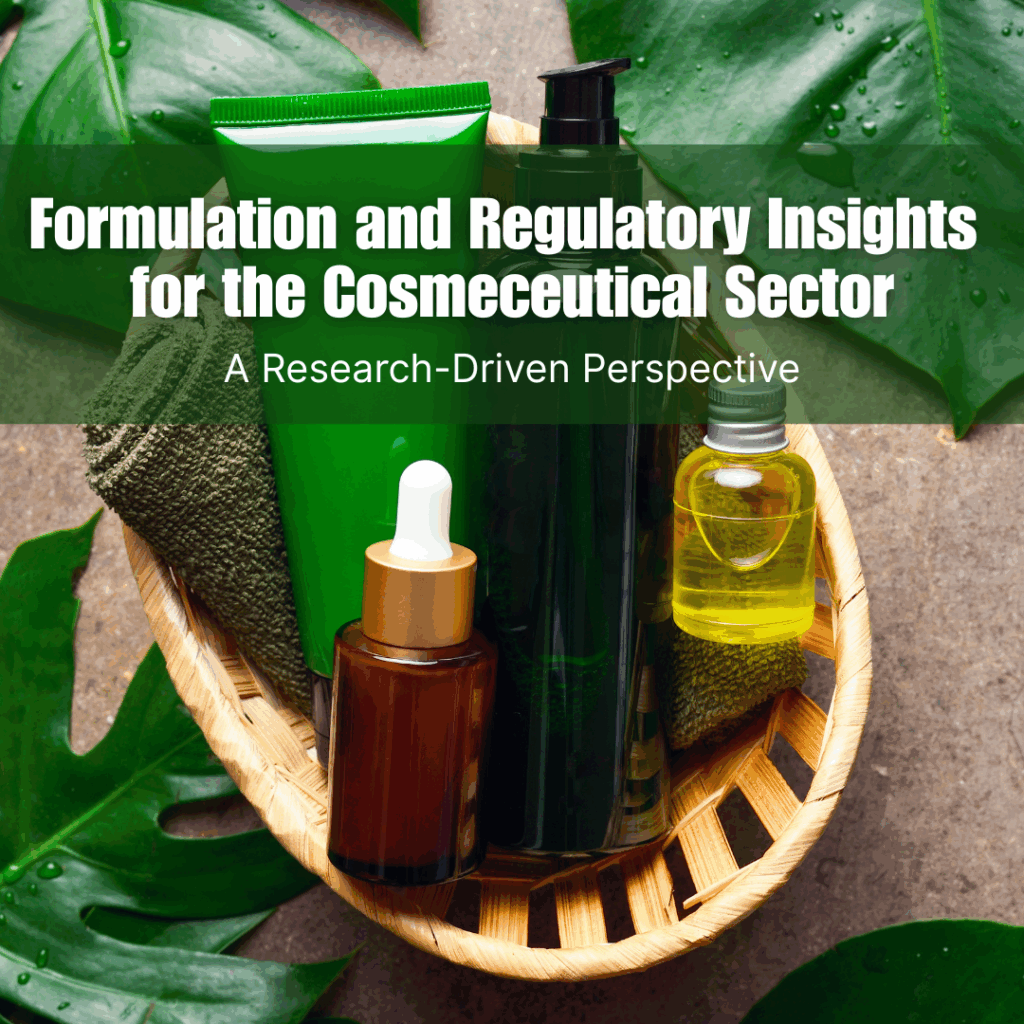Cosmeceuticals have become a vibrant sector that straddles the worlds of cosmetics and pharmaceuticals, based solely on the demand from consumers for products that provide both aesthetic improvement and therapeutic enhancement. These products have been formulated as topical applications, such as anti-aging serums, skin brightening agents, and acne therapeutics, often containing active biologic compounds that directly impact skin biology. [1]
Formulation and Regulatory Insights for the Cosmeceutical Sector: A Research-Driven Perspective
Cosmeceuticals have become a vibrant sector that straddles the worlds of cosmetics and pharmaceuticals, based solely on the demand from consumers for products that provide both aesthetic improvement and therapeutic enhancement. These products have been formulated as topical applications, such as anti-aging serums, skin brightening agents, and acne therapeutics, often containing active biologic compounds that directly impact skin biology. [1]
Whereas traditional cosmetics had nearly no functional claims beyond improved appearance, cosmeceuticals contain functional claims such as wrinkle reduction, improved skin tone, texture and radiance, which are the basis for their claim to provide therapeutic benefits. They represent a unique challenge for manufacturers from a formulation, clinical level evidence and regulatory perspective that balance functionality with safety and compliance. [2]
Understanding the Cosmeceutical Market
Definition and Regulatory Status
The ASEAN TMHS SC [Traditional Medicines and Health Supplements Scientific Committee] plays a central role in developing the scientific and regulatory guidelines for ensuring product safety, quality and efficacy. The scientific committee fronted the development of the ASEAN Guidelines on Health Supplements, which are aimed to harmonize the technical requirements across the ASEAN countries. The key achievements of the scientific committee include the acceptance of common definitions, guiding principles of food additives and excipients, safety evaluation criteria, permitted claims and claims substantiation for traditional medicines and health supplements, and labelling standards. The harmonization of the regulatory frameworks will strengthen consumer protection and market access within Southeast Asia.
Market Growth in India
India’s cosmeceutical market is growing rapidly due to more people being aware of skin care, increasing urbanization and having access to global beauty trends via digital and e-commerce. The demand is focused on anti-aging, skin-repair and pigmentation treatments, which aligns with a movement towards aesthetics in conjunction with dermatological needs.
Global Market Overview
- Market Size for 2024: USD 68.67 billion
- 2025 Forecast: USD 74.31 billion
- 2032 Projection: USD 138.26 billion CAGR (2025–2032): 9.3%
In 2024, the Asia-Pacific region will lead the global market by 41.31%. Demographically, India is positioned to be a major contributor to this growth trend as increased disposable income, combined with better awareness of skincare is building the market.

Key Growth Drivers
- Rise in Skin Disorders The worldwide rise of acne, eczema, and hyperpigmentation has caused an increased use of advanced skincare options to relieve the condition as well as have cosmetic effects.
- Dermatological Endorsement Many dermatologists are beginning to recommend cosmeceuticals instead of other treatments because cosmeceuticals have therapeutic efficacy along with cosmetic benefit.
- E-commerce Expansion Leading brands are investing in direct-to-consumer e-commerce to capitalize on their customer base and expand their product exposure, especially in fast-developing markets like India. [4]
R&D Priorities: Beyond Cosmetic Appeal
What makes a cosmeceutical successful isn’t the look or the smell, but rather the science behind the chemistry and proven results. The focus of research priorities will include:
- Active Ingredient Selection: Some ingredients that are most used in these products include retinoids, niacinamide, peptides, and alpha hydroxy acids (AHAs). These are not only relevant to how we want to use them.
- Delivery Systems: Nanocarriers, liposomes, microemulsions are used to, increase bioavailability or provide a targeted delivery of the active ingredient through the stratum corneum.
- Synergistic Formulations: There is increased interest in multi-functional products that have synergistic activity of anti-inflammatory, antioxidant and moisturizing activity.
- Scientific validation: using in vitro, in vivo, and dermatological studies is necessary to substantiate the claims and have credible products. [5]
Table 1: Common Cosmeceutical Actives and Their Functions with examples
Active Ingredient | Function | Delivery System | Example Product/Insight |
Retinoids | Stimulate collagen, reduce wrinkles | Nanocarriers | ROC Retinol Correxion: enhanced penetration |
Niacinamide | Strengthens barrier, enhances brightness | Microemulsions | The Ordinary Niacinamide 10% + Zinc 1% |
Peptides | Repairs skin, tightens skin | Liposomes | Matrixyl 3000; stimulates collagen stimulation |
AHAs | Exfoliate, smooths skin | Time-release patches | Glycolic acid peels with extension release |
Challenges in Formulation
Cosmeceutical formulation is more complicated than “standard” cosmetics. Some examples of the challenges are:
- Optimizing Emulsion Delivery Systems: Designing emulsions that deliver active ingredients through the skin’s most significant barrier, the stratum corneum, to the viable epidermis. The partition coefficient, penetrant polarity, and other factors to aid skin absorption are critical factors.
- Sourcing Clean-Label Sustainable Actives: Identifying innovative actives that achieve clean beauty expectations, namely that are environmentally friendly, naturally sourced, and low carbon footprint, are multifunctional, and compatible within complex formulations.
- Improving Skin Molecular Biology Knowledge: Increasing our knowledge of some functionally relevant molecular and cellular characteristics of skin areas will create more accurate and effective cosmetic formulations, reducing wasted time, money, and effort.
- pH and Stability Management: Ensuring actives like vitamin C remain stable by preventing rapid degradation or oxidation caused by exposure to air and light, while maintaining their efficacy.
- Skin Tolerance and Sensory Attributes: Designing products that deliver the intended benefits without causing irritation, especially important for sensitive or compromised skin types.
- Preservation and Packaging Solutions: Addressing microbial risks associated with water-based formulations through appropriate preservation systems and packaging that protects product integrity and prevents contamination. [6]
Case Study Title: Enhancing Skin Penetration of Retinol via Nanoemulsion Delivery System
- Challenge: Retinol’s poor skin penetration and instability upon exposure to air and light limited its efficacy in topical formulations.
- Solution: Developed a nanoemulsion-based delivery system optimized for retinol encapsulation, improving its partitioning through the stratum corneum. Combined with antioxidant stabilizers and opaque, airtight packaging to prevent degradation.
Outcome: Achieved a 35% increase in bioavailability and maintained retinol stability for over 4 months under accelerated storage conditions, resulting in improved clinical efficacy in reducing fine lines and wrinkles.
Regulatory Considerations in India
India does not have an official “cosmeceuticals” category, unfortunately, but these products will fall under the Drugs and Cosmetics Act of 1940; the rules from 1945; and BIS labelling and quality specifications. Cosmeceuticals, under these regulations will be considered cosmetics, and each product must still meet BIS formulation and packaging standards. Specifically, Schedule “S” of the Drugs and Cosmetics Rules of 1945 lists the various BIS standards for compliance. We will use BIS standards for our cosmeceuticals: e.g., IS 6608:2004 for skin creams; and IS 9875:1990 for lipsticks.
Some of the challenges while registering cosmeceuticals would be:
- Safety Assessments: Compliance requires detailed safety data including skin irritation and sensitization studies, and toxicity data. IS 6608:2004 states that all raw materials must be tested for heavy metals (i.e., arsenic, lead, etc.). If the raw materials are compliant with the permissible limits used at the beginning of the product development phase, it may not be necessary to do the final products heavy metal testing.
- Labeling Compliance: Accuracy of claims backed up by credible science and the order of the ingredients based on their concentration form part of the labelling requirements; misleading health claims must be avoided.
- Importing Legal and Licensing Framework: Chapter III of the Drugs and Cosmetics Act governs the import of such products. As far as cosmeceuticals, if any of the active ingredients claim therapeutic benefits or if manufacturing outside of India, and along with the usual requirements for cosmetic registration, additional regulatory import permits and a drug license must be applied.
Given the grey areas in and around the regulations; good documentation, transparency in sourcing of ingredients and science to support your claims and features is paramount. [7]
Trends Driving Innovation
The cosmeceutical sector is one that is intense with innovation and there are many trends that will continue to shape the development of products in the future:
- Personalized Skincare: Skin diagnostics powered by artificial intelligence, and custom skincare formulations, are no longer just a nice-to-have; they are increasingly common.
- Microbiome Care: Prebiotics, probiotics, and postbiotics, are also being increasingly included in formulations to provide a balanced skin microbiota.
- Clean Beauty & Green Formulations: Free-from paraben, sulphate, and cruelty conditions are increasingly being mandated by consumers, which has led the R&D industry to develop sustainable alternatives.
- Tech-Enabled Delivery: Smart applicator devices, patches, and timed-release products. enhancement user experience and efficacy.
All these trends and developments require a strong scientific backing, with key input from R&D teams with a background in dermatological science, and knowledge of delivery systems. [8]
Integrating Research, Regulation, and Market Readiness
To find success in the cosmeceutical sector, manufacturers should take an integrated approach that combines:
- Scientific Research: Empirical studies demonstrating efficacy of ingredients and formulations.
- Regulatory Mapping: Understanding the Indian regulatory landscape as well as worldwide regulatory regulations to launch compliant product.
- Consumer-Centric Design: Finding the right balance of efficacy with sensory benefits, and sustainability.
This intersection of science, compliance, and innovation is where research partners and formulation specialists play a key role, especially when it comes to accelerating product development, and reducing regulation risk. [1]
Example of Case Study
Case Study
Title: Registering a Cosmeceutical in India with a US-origin active.
- Background: US-origin active (Bakuchiol) used in anti-aging serum.
- Problem: Delays in import clearance because of therapeutic claims.
- Solution: Reformulated the product in-compliance with cosmetic classification, supplied local data for safety.
Result: Marketed as cosmetic but with a functional claim; no drug licensing was needed.
Conclusion
Cosmeceuticals are not just something added onto cosmetics; they are a scientific, function category that requires diligence in R&D and compliance. For people involved in the Indian or global market, a sector specific strategy based on scientific originations and prudent regulatory planning is crucial.
With dedicated cosmeceutical research and specialist support, companies can be confident that their products are not only efficacious, but trusted, compliant and future proof.
For trustworthy cosmeceutical product development that meets all regulatory compliance requirements, contact FRL today to create a quality cosmetic.

Let’s create something Innovative and Delicious together
Food Research Lab strives for excellence in new Food, Beverage and Nutraceutical Product Research and Development by offering cutting edge scientific analysis and expertise.




